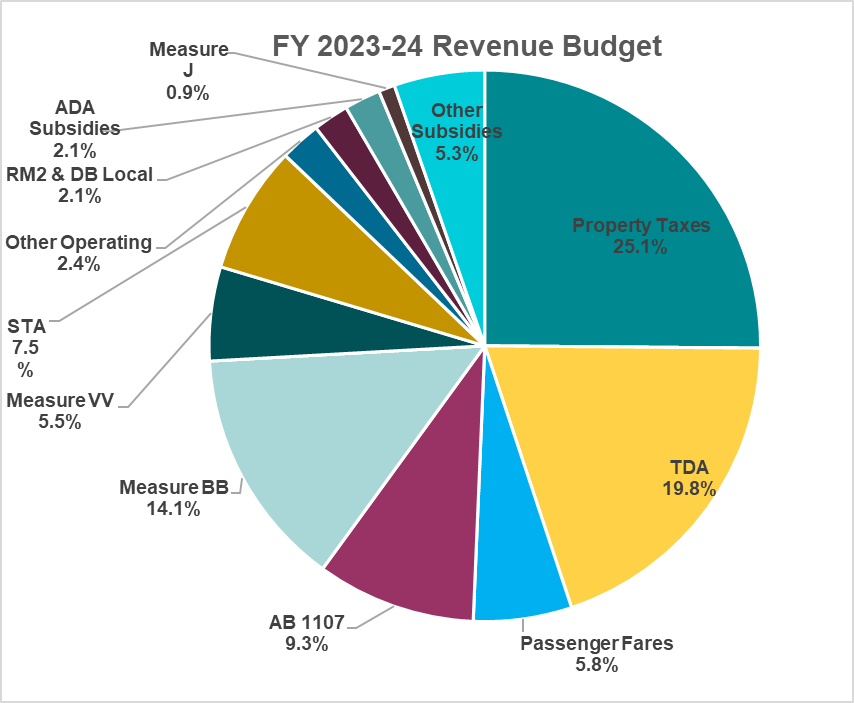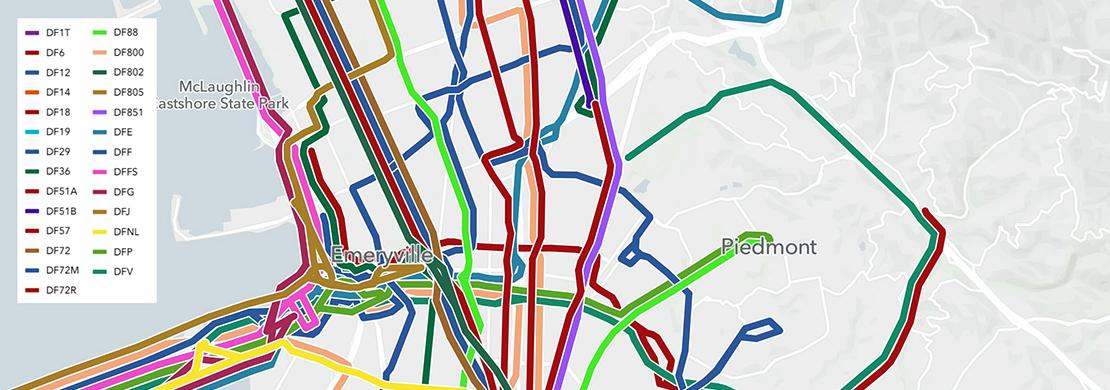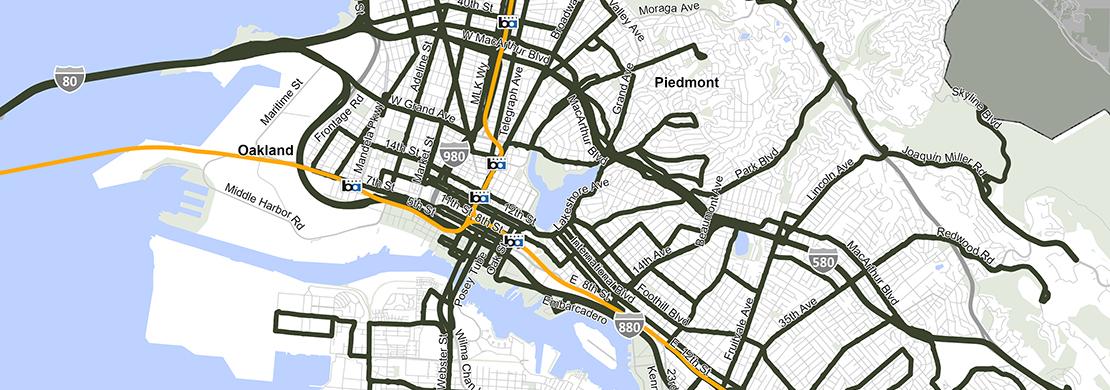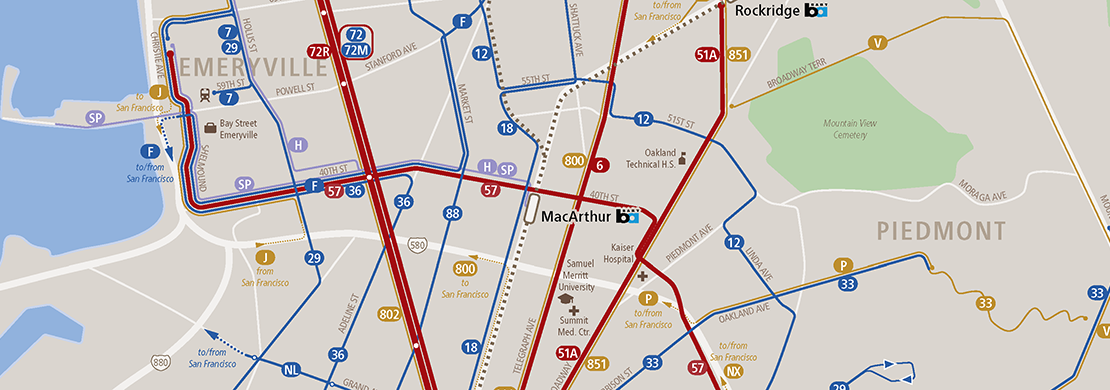AC Transit Realign Archive
On October 9, the AC Transit Board of Directors voted to approve the Realign Final Network Plan. Find the Final Network Plan in the resources below, or visit the Draft Final Plan page for more tools to explore the near-final draft. Realign implementation is slated to launch as soon as August 2025. Stay tuned for updates to the launch timeline. This page will be updated in Spring 2025.
Goals
- Assess today’s travel patterns and the community’s current AC Transit service needs.
- Implement an inclusive planning process that incorporates quantitative and qualitative data along with rider and community feedback – including the voices of hard-to-reach equity communities.
- Align service schedules, coverage, and frequencies based on major needs identified by the community, riders, travel pattern data, finances, and workforce availability.
- Update our service standards with best practices for the design of our bus service.

Why Realign?
Ridership has not rebounded to pre-pandemic levels, with more people working remotely or adopting hybrid work models. The decline in ridership directly corresponds with a reduction in farebox and local tax revenues, which are essential for funding operations. AC Transit's bus network faces additional challenges due to unstable state and federal funding and the difficulty recruiting frontline employees, particularly Bus Operators. Due to these financial constraints, Realign is a resource-neutral plan that requires tradeoffs within its proposed recommendations.

Realign Draft Final Plan
The AC Transit Realign Draft Final Plan prioritizes bus lines serving transit dependent communities, improves reliability, and optimizes service efficiency while allowing for potential future growth. The Draft Final Plan suggests several types of changes to our service, including re-routing lines, combining or potentially eliminating others, and frequency and service hour adjustments. All proposed changes to bus lines are identified in the Plan with the label "DF.”

Unconstrained Vision Scenario
With direction from the AC Transit Board of Directors, an unconstrained vision as presented during Phase 3 will be moved forward on a longer timeframe than the immediate service changes. This extended time will allow for staff and community focus on the near-term Realign Plan as well as provide additional time to refine an unconstrained vision plan for Board and community consideration after an updated Service Standard Policy is approved. These recommendations will follow a separate process in early 2025.

Service Standards
In summer of 2024, the Realign project team will update AC Transit’s service standards. This effort will take all public input received over the course of the project and combine it with the latest planning practices to draft a blueprint for how the agency will plan service and measure its performance now and into the future.
Phases & Timeline*
*Timeline is preliminary and subject to change

Phase 1 - Develop Plans and Learn Rider Needs
Dates: March - June 2023
Realign begins with a thorough analysis of current AC Transit service area conditions. The habits, needs, concerns, and priorities of riders and community members will be identified during this phase through quantitative data review, customer survey responses, and feedback through robust outreach. This phase encourages survey participation, which begins April 17, 2023. The survey will help us understand what’s important, identify priority destinations/connections, and weigh trade-offs/priorities that will inform the development of a draft set of guiding principles.

Phase 2 - Aligning Guiding Principles with Community Assessment
Dates: July - August 2023
This phase will solicit and incorporate feedback from riders, community members and AC Transit’s Board of Directors on the draft guiding principles developed from information gathered in Phase 1. In this phase, a final Guiding Principles document will be adopted by the Board and will establish the support, clarity, and direction for the development of Realign (new bus service network plan).

Phase 3 - Develop Service Scenarios and Gather Feedback
Dates: September - December 2023
Based on the feedback and direction from the first two phases, this phase presents draft service scenarios that offer alternative configurations of AC Transit’s routes and schedules throughout our service area. This is an important opportunity for our riders and community to provide feedback on these service scenarios.

Phase 4 - Draft Final Service Plan and Plan Adoption
Dates: January - October 2024
Following the comprehensive review of data and community input on the draft scenarios, a draft Final Service Plan will be created, including an extensive update to AC Transit’s Service Standards. The draft Final Service Plan will be shared with the community during a formal public comment process. The Realign process will culminate with review and a formal vote by the AC Transit Board of Directors. An Equity Analysis (under Title VI of the American Civil Rights Act) will ensure that any negative impacts on both minority and low-income populations will be identified and presented for approval on a parallel track.

Phase 5 - Develop Service Standards and Inform Riders about Service Changes
Dates: October 2024 - August 2025
Once the Final Service Plan and updated Service Standards are approved, the new service is expected to begin in August 2025. In this final phase, robust promotion will educate riders and community members on how to use the new service network. The updated service policies and standards will help guide future planning and monitoring of AC Transit’s service network. These standards, including hours, days of operation, frequency, and location of bus routes, will guide how service we will operate on the streets and in neighborhoods throughout the AC Transit service area. The standards are based upon multiple factors, including equity, land use, population density, access to jobs, commercial activity, and major attractors such as schools, hospitals, and grocery stores.
Additional Resources

Additional Resources
- Interactive Story Map on Existing Conditions
- Existing Conditions Executive Summary
- Service Profile
- Market Analysis
- Origin-Destination Analysis Memo
- Ridership Summary Memo
- Individual Route Profiles (Fall 2019)
- Individual Route Profiles (Fall 2022)
- Survey Results Technical Memo
- Outreach and Engagement Summary
- Guiding Principles Memo
- Balanced Coverage Scenario
- Frequent Service Scenario
- Realign Data
- Draft Service Proposal (January 2024)
- Realign Overview Fact Sheet
- Final Network Plan (Approved, October 2024)

Board of Directors Meeting Materials
- September 11, 2024 6pm Realign Public Hearing
- September 11, 2024 2pm Realign Public Hearing
- September 10, 2024 Realign Public Hearing
- September 9, 2024 Realign Public Hearing
- June 5, 2024 Board of Directors Special Meeting
- March 13, 2024 Board Meeting Presentation (Timeline update plus consultant extension) | Video
- January 24, 2024 Board Meeting Presentation
- December 13, 2023 Board Meeting Presentation
- November 1, 2023 Board Workshop Presentation
- September 13, 2023 Board Meeting Presentation
- July 26, 2023 Board Workshop Presentation
- July 26, 2023 Board Meeting Financial Update
- June 28, 2023 Board Meeting Presentation
- May 24, 2023 Board Meeting Presentation
- April 26, 2023 Board Meeting Presentation
- Line DF1T: Map | Hi-Res
- Line DF6: Map | Hi-Res| Changes
- Line DF7: Map | Hi-Res | Changes
- Line DF10: Map | Hi-Res| Changes
- Line DF12: Map | Hi-Res
- Line DF14: Map | Hi-Res
- Line DF18: Map | Hi-Res | Changes
- Line DF19: Map | Hi-Res| Changes
- Line DF20: Map | Hi-Res| Changes
- Line DF21: Map | Hi-Res | Changes
- Line DF27: Map | Hi-Res | Changes
- Line DF28: Map | Hi-Res | Changes
- Line DF29: Map | Hi-Res | Changes
- Line DF33: Map | Hi-Res
- Line DF34: Map | Hi-Res
- Line DF35: Map | Hi-Res | Changes
- Line DF36: Map | Hi-Res | Changes
- Line DF39: Map | Hi-Res
- Line DF40: Map | Hi-Res
- Line DF41: Map | Hi-Res
- Line DF45: Map | Hi-Res | Changes
- Line DF46L: Map | Hi-Res
- Line DF51A: Map | Hi-Res | Changes
- Line DF51B: Map | Hi-Res | Changes
- Line DF52: Map | Hi-Res
- Line DF54: Map | Hi-Res
- Line DF56: Map | Hi-Res
- Line DF57: Map | Hi-Res
- Line DF60: Map | Hi-Res
- Line DF62: Map | Hi-Res
- Line DF65: Map | Hi-Res
- Line DF67: Map | Hi-Res
- Line DF70: Map | Hi-Res | Changes
- Line DF71: Map | Hi-Res
- Line DF72: Map | Hi-Res | Changes
- Line DF72M: Map | Hi-Res
- Line DF72R: Map | Hi-Res
- Line DF73: Map | Hi-Res | Changes
- Line DF74: Map | Hi-Res | Changes
- Line DF76: Map | Hi-Res | Changes
- Line DF79: Map | Hi-Res
- Line DF86: Map | Hi-Res | Changes
- Line DF88: Map | Hi-Res | Changes
- Line DF90: Map | Hi-Res
- Line DF93: Map | Hi-Res
- Line DF95: Map | Hi-Res
- Line DF96: Map | Hi-Res | Changes
- Line DF97: Map | Hi-Res
- Line DF98: Map | Hi-Res
- Line DF99: Map | Hi-Res
- Line DF200: Map | Hi-Res | Changes
- Line DF210: Map | Hi-Res
- Line DF212: Map | Hi-Res | Changes
- Line DF215: Map | Hi-Res
- Line DF216: Map | Hi-Res | Changes
- Line DF217: Map | Hi-Res | Changes
- Line DF232: Map | Hi-Res | Changes
- Line DF239: Map | Hi-Res | Changes
- Line DF251: Map | Hi-Res
- Line DF299: Map | Hi-Res | Changes
- Line DF376: Map | Hi-Res
- Line DF800: Map | Hi-Res
- Line DF801: Map | Hi-Res
- Line DF802: Map | Hi-Res
- Line DF805: Map | Hi-Res | Changes
- Line DF840: Map | Hi-Res
- Line DF851: Map | Hi-Res
- Line DFE: Map | Hi-Res
- Line DFF: Map | Hi-Res
- Line DFFS: Map | Hi-Res
- Line DFG: Map | Hi-Res
- Line DFJ: Map | Hi-Res
- Line DFL: Map | Hi-Res | Changes
- Line DFLA: Map | Hi-Res
- Line DFNL: Map | Hi-Res
- Line DFNX: Map | Hi-Res
- Line DFNX3: Map | Hi-Res
- Line DFO: Map | Hi-Res | Changes
- Line DFOX: Map | Hi-Res
- Line DFP: Map | Hi-Res
- Line DFU: Map | Hi-Res
- Line DFV: Map | Hi-Res
- Line DFW: Map | Hi-Res | Changes
- Line DFWMZ: Map | Hi-Res | Changes